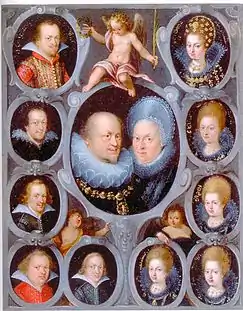Frederick I, Duke of Württemberg
Friedrich I of Württemberg (19 August 1557 – 29 January 1608) was the son of George of Mömpelgard and his wife Barbara of Hesse, daughter of Philip I, Landgrave of Hesse.
Frederick I, Duke of Württemberg | |
|---|---|
.jpg.webp) Frederick I, Duke of Württemberg | |
| Born | 19 August 1557 Mömpelgard, today's Montbéliard |
| Died | 29 January 1608 (aged 50) Stuttgart |
| Noble family | House of Württemberg |
| Spouse(s) | Sibylla of Anhalt |
| Father | George I of Württemberg-Mömpelgard |
| Mother | Barbara of Hesse |
Several references are made to him in Shakespeare's The Merry Wives of Windsor, in which a series of anti-German jokes start with a horse theft, several references are made to German travellers in England and to a German duke who is not expected to come to Windsor.

Early life and education
Frederick of Mömpelgard was born in Mömpelgard present day Montbéliard, France, the son of George I of Württemberg-Mömpelgard of Montbéliard and his wife Barbara of Hesse, daughter of Philip I, Landgrave of Hesse.
He spent his youth at the Württemberg court in Stuttgart, where Christoph, Duke of Württemberg himself took care of his education. From 1571 to 1574 he was educated in the later Collegium Illustre in Tübingen
Career
Fredeick visited various courts in Germany, Denmark, Hungary, Austria, France, Italy and England. Frederick signed the Formula of Concord of 1577 and the Book of Concord of 1580.
In 1592, he was heir apparent to the dukedom of Württemberg when he visited Windsor and other English cities. He desired to become a Knight of the Garter and repeatedly solicited Queen Elizabeth for the honor. After he had inherited the dukedom and become more prominent, she admitted him to the order. In a calculated slight, he was not informed of his admission in time to attend the investiture in spring 1597, the ceremony for which The Merry Wives of Windsor was written. Thus references to Mömpelgard's earlier visit and his not being in Windsor were jokes intended for the play's first audience, and appear in the First Folio edition of the play, taken from the first private performance, but not in the 1602 Quarto derived from public theatrical production. It was not until October 4, 1603, that he received the investiture by a delegation of Queen Elizabeth I.[1]
According to another account, in May 1604 King James I sent William Dethick to invest Frederick in the order, nd he presented jewels including two garters with diamonds and rubies, and two St Georges with diamonds and rubies, and a gold chain or collar, made by the London goldsmiths, John Spilman and William Herrick.[2]
In 1599, Frederick I issued an order that a new town should be established at the northern extremity of the Black Forest by the name of Freudenstadt. The aim was for the town to become the new residence of the Duchy of Württemberg as it was closer to Mömpelgard than the Württemberg capital Stuttgart. However, Frederick I died in 1608, aged 50, in Stuttgart, and his plans never came to fruition.
Children
The sons of Frederick I established the ducal house of Württemberg-Neuenstadt, a branch line of the House of Württemberg after a Fürstbrüderlicher Vergleich – a mutual agreement made between ducal brothers on 7 June 1617. The eldest son, Johann Friedrich, assumed barony over the Duchy of Württemberg while the second youngest son, Frederick Achilles, was bequeathed Neuenstadt Castle and an annual endowment of 10,000 guilder.

Frederick and his spouse Sibylla of Anhalt (1564–1614), daughter of Joachim Ernst, Prince of Anhalt, had the following children:
- Johann Frederick (1582–1628)
- George Frederick (1583–1591)
- Sibylla Elisabeth (1584–1606) - married John George I, Elector of Saxony
- Elisabeth (born and died in 1585)
- Louis Frederick (1586–1631), founder of the later branch line of Württemberg-Mömpelgard
- Joachim Frederick (born and died in 1587)
- Julius Frederick (1588–1635), founder of the branch line of Württemberg-Weiltingen, also known as the Julian Line
- Philip Frederick (born and died in 1589)
- Eva Christina (1590–1657) - married John George of Brandenburg (1577–1624), Duke of Jägerndorf, son of Joachim Frederick, Elector of Brandenburg
- Frederick Achilles (1591–1631)
- Agnes (1592–1629) - married Francis Julius of Saxe-Lauenburg (1584–1634)
- Barbara (1593–1627) - married Margrave Frederick V of Baden-Durlach
- Magnus (de) (1594–1622), fell in the Battle of Wimpfen
- August (born and died in 1596)
- Anna (1597–1650)
Ancestors
| Ancestors of Frederick I, Duke of Württemberg | |||||||||||||||||||||||||||||||||||||||||||||||||||||||||||||||||||||||||||||||||||||||||||||||||||||||||||||||||||||||||||||||||||||||||||||||||||||||||||||||||||||||||||||||||||||||||||||||||||||||||||||||||||||||||||||||||||||||||||||||||||||||||||||||||||||||||||||||||||||||||
|---|---|---|---|---|---|---|---|---|---|---|---|---|---|---|---|---|---|---|---|---|---|---|---|---|---|---|---|---|---|---|---|---|---|---|---|---|---|---|---|---|---|---|---|---|---|---|---|---|---|---|---|---|---|---|---|---|---|---|---|---|---|---|---|---|---|---|---|---|---|---|---|---|---|---|---|---|---|---|---|---|---|---|---|---|---|---|---|---|---|---|---|---|---|---|---|---|---|---|---|---|---|---|---|---|---|---|---|---|---|---|---|---|---|---|---|---|---|---|---|---|---|---|---|---|---|---|---|---|---|---|---|---|---|---|---|---|---|---|---|---|---|---|---|---|---|---|---|---|---|---|---|---|---|---|---|---|---|---|---|---|---|---|---|---|---|---|---|---|---|---|---|---|---|---|---|---|---|---|---|---|---|---|---|---|---|---|---|---|---|---|---|---|---|---|---|---|---|---|---|---|---|---|---|---|---|---|---|---|---|---|---|---|---|---|---|---|---|---|---|---|---|---|---|---|---|---|---|---|---|---|---|---|---|---|---|---|---|---|---|---|---|---|---|---|---|---|---|---|---|---|---|---|---|---|---|---|---|---|---|---|---|---|---|---|---|---|---|---|---|---|---|---|---|---|---|---|---|---|---|---|---|
| |||||||||||||||||||||||||||||||||||||||||||||||||||||||||||||||||||||||||||||||||||||||||||||||||||||||||||||||||||||||||||||||||||||||||||||||||||||||||||||||||||||||||||||||||||||||||||||||||||||||||||||||||||||||||||||||||||||||||||||||||||||||||||||||||||||||||||||||||||||||||
References
- John Nichols (1828). The Progresses, Processions, and Magnificient Festivities of King James the First. London: printed by and for J. B. Nichols. p. 282.
- HMC Laing Manuscripts at the University of Edinburgh, vol. 1 (London, 1914), pp. 93-7.
Further reading
- Paul Friedrich von Stälin: "Friedrich I., Herzog von Württemberg". In: Allgemeine Deutsche Biographie (ADB). Vol. 8, p45–48.
- Paul Sauer: Herzog Friedrich I. von Württemberg 1557-1608. Ungestümer Reformer und weltgewandter Autokrat. Stuttgart 2003.